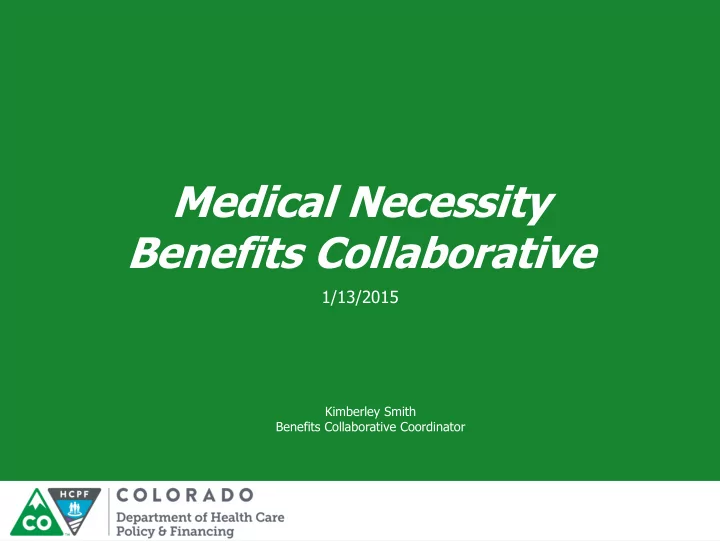

Medical Necessity Benefits Collaborative 1/13/2015 Kimberley Smith Benefits Collaborative Coordinator
Our Mission Improving health care access and outcomes for the people we serve while demonstrating sound stewardship of financial resources
What is the Benefits Collaborative Process?
Medical Necessity Defining the Term Kimberley Smith Benefits Collaborative Coordinator
Why the Department is Creating a Single Definition of Medical Necessity Multiple definitions of Medical Necessity exist within Colorado Medicaid Volume 8 rule and within various Department contracts. Multiple definitions create unnecessary confusion Multiple definitions cause staff, clients, providers and others needless investigative work It is administratively burdensome to keep all definitions updated and consistent with one another It is difficult to hold vendors and providers to the same standard Creating a single definition is the right thing to do in terms of being transparent
What This Effort is Not This effort is not about taking anything away from anyone The creation of a single definition of Medical Necessity does not mean there is only one way to apply that definition. Example: The definition states that medically necessary services must be clinically appropriate in terms of amount, scope and duration. However, what constitutes the clinically appropriate amount, scope and duration of services for a particular benefit (such as transplants or pediatric personal care services) may be outlined in federal rule or may be something we determine together in a Benefits Collaborative Process.
Medical Necessity Definitions: Let’s look at two examples currently found in Colorado Medicaid Rule
Program Integrity Definition, Section 8.076.1.8. Medical necessity means a Medical Assistance program good or service that will, or is reasonably expected to prevent, diagnose, cure, correct, reduce, or ameliorate the pain and suffering, or the physical, mental, cognitive, or developmental effects of an illness, injury, or disability. It may also include a course of treatment that includes mere observation or no treatment at all. The good or service must be: i) Provided in accordance with generally accepted standards of medical practice in the United States; ii) Clinically appropriate in terms of type, frequency, extent, site, and duration; iii) Not primarily for the economic benefit of the provider or for the convenience of the client, caretaker, or provider; and iv) Performed in a cost effective and most appropriate setting required by the client's condition.
Program Integrity Definition is the Standard Definition Most sections of Colorado Medicaid Rule that reference the terms “medical necessity” or “medically necessary” refer back to the Program Integrity definition found in 10 C.C.R. 2505-10, Section 8.076.1.8. Example: 8.200.3.A Physician services are reimbursable when the services are a benefit of Medicaid and meet the criteria of Medical Necessity as defined in 10 C.C.R. 2505-10, Section 8.076.1.8 This is the definition that the Program Integrity Division applies when assessing claims for potential fraud and abuse This is the definition that the Department’s Utilization Management vendor uses to approve or deny services that require prior-authorization
Hospital Services Definition, Section 8.300.1 The definition below is an example of an alternative definition of Medical Necessity found in rule that is similar to the Program Integrity definition, but not identical Medically Necessary, or Medical Necessity, means a Medicaid service that will, or is reasonably expected to pre-vent, diagnose, cure, correct, reduce or ameliorate the pain and suffering, or the physical, mental, cognitive or develop-mental effects of an illness, injury, or disability; and for which there is no other equally effective or substantially less costly course of treatment suitable for the client's needs.
More on Multiple Definitions Additional alternative definitions of Medical Necessity exist under, for example, the Dental and EPSDT sections of rule. W hen the term “medical necessity” or “medically necessary” is used elsewhere in rule, without definition or citation, it is not clear to the reader which definition should be referenced. Example: COUP rule 8.075.4 - Overutilization means the improper or excessive utilization of medical care and services that are not medically necessary.
Department Proposal Create a single, uniform definition of Medical Necessity that can be referenced throughout rule and that will live under the Program Integrity section of rule at 10 C.C.R. 2505-10, Section 8.076.1.8. Where medical necessity is mentioned elsewhere in rule, include citation back to the definition found at 8.076.1.8 Uniform definition would be very similar to current Program Integrity definition.
Department Proposal Where the special nature of a program, benefit or service requires that the Medical Necessity definition in rule be expanded, a citation to the definition found at 8.076.1.8 would be followed by the additional criteria. Example: 8.200.3.A - Physician services are reimbursable when the services are a benefit of Medicaid and meet the criteria of Medical Necessity as defined in 10 C.C.R. 2505-10, Section 8.076.1.8 and are provided by the appropriate provider specialty.
Proposed Uniform Definition Medical necessity means a Medical Assistance program good or service that will, or is reasonably expected to prevent, diagnose, cure, correct, reduce, or ameliorate the pain and suffering, or the physical, mental, cognitive, or developmental effects of an illness, condition, injury, or disability. It may also include a course of treatment that includes mere observation or no treatment at all. A good or service is medically necessary only if: a) It is provided in accordance with generally accepted standards of medical practice in the United States; and b) It is clinically appropriate in terms of type, frequency, extent, site, and duration; and c) It is not primarily for the economic benefit of the provider or for the convenience of the client, caretaker, or provider; and d) There is no equally effective and less costly treatment option for the medical problem; and e) It is delivered in the most appropriate setting required by the client’s condition; and f) It is not experimental or investigational.
Let’s Compare the Current Definition to the Proposed Definition
Discussion
Comparison of EPSDT Medical Necessity Definition to Newly Proposed Definition
Comparison Continued
Thank You
Recommend
More recommend